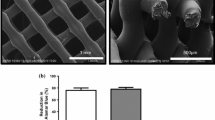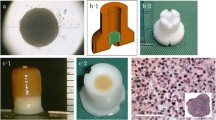Abstract
Cartilage tissue engineering is a multifactorial problem requiring a wide range of material property requirements from provision of biological cues to facilitation of mechanical support in load-bearing diarthrodial joints. The study aim was to design, fabricate and characterize a template to promote endogenous cell recruitment for enhanced cartilage repair. A polylactic acid poly-ε-caprolactone (PLCL) support structure was fabricated using laser micromachining technology and thermal crimping to create a functionally-graded open pore network scaffold with a compressive modulus of 9.98 ± 1.41 MPa and a compressive stress at 50% strain of 8.59 ± 1.35 MPa. In parallel, rabbit mesenchymal stem cells were isolated and their growth characteristics, morphology and multipotency confirmed. Sterilization had no effect on construct chemical structure and cellular compatibility was confirmed. After four weeks implantation in an osteochondral defect in a rabbit model to assess biocompatibility, there was no evidence of inflammation or giant cells. Moreover, acellular constructs performed better than cell-seeded constructs with endogenous progenitor cells homing through microtunnels, differentiating to form neo-cartilage and strengthening integration with native tissue. These results suggest, albeit at an early stage of repair, that by modulating the architecture of a macroporous scaffold, pre-seeding with MSCs is not necessary for hyaline cartilage repair.







Similar content being viewed by others
References
Ahmadbeigi, N., A. Shafiee, E. Seyedjafari, Y. Gheisari, M. Vassei, S. Amanpour, S. Amini, I. Bagherizadeh, and M. Soleimani. Early spontaneous immortalization and loss of plasticity of rabbit bone marrow mesenchymal stem cells. Cell Prolif. 44:67–74, 2011.
Barron, V., K. Merghani, G. Shaw, C. M. Coleman, J. S. Hayes, S. Ansboro, A. Manian, G. O’Malley, E. Connolly, A. Nandakumar, C. A. van Blitterswijk, P. Habibovic, L. Moroni, F. Shannon, J. M. Murphy, and F. Barry. Evaluation of cartilage repair by mesenchymal stem cells seeded on a PEOT/PBT scaffold in an osteochondral defect. Ann. Biomed. Eng. 43:2069–2082, 2015.
Brittberg, M. Cell carriers as the next generation of cell therapy for cartilage repair: a review of the matrix-induced autologous chondrocyte implantation procedure. Am. J. Sports Med. 38:1259–1271, 2010.
Chou, C.-L., A. L. Rivera, T. Sakai, A. I. Caplan, V. M. Goldberg, J. F. Welter, and H. Baskaran. Micrometer scale guidance of mesenchymal stem cells to form structurally oriented cartilage extracellular matrix. Tissue Eng. Part A 2012. doi:10.1089/ten.TEA.2012.0177.
European Medicines Agency. MACI: EPAR Summary for the public. 2014.
Farr, J., B. J. Cole, S. Sherman, and V. Karas. Particulated articular cartilage: CAIS and DeNovo NT. J. Knee Surg. 25:23–29, 2012.
Freed, L. E., I. Martin, and G. Vunjak-Novakovic. Frontiers in tissue engineering. In vitro modulation of chondrogenesis. Clin. Orthop. 367:S46–58, 1999.
Guilak, F., D. L. Butler, S. A. Goldstein, and D. Mooney. Functional tissue engineering. Berlin: Springer, 2004; (452pp).
Hababovic, P. Predictive value of in vitro and in vivo assays. In: Tissue engineering, edited by J. P. Fisher. Berlin: Springer, 2006.
Hurtig, M. B., M. D. Buschmann, L. A. Fortier, C. D. Hoemann, E. B. Hunziker, J. S. Jurvelin, P. Mainil-Varlet, C. W. McIlwraith, R. L. Sah, and R. A. Whiteside. Preclinical studies for cartilage repair recommendations from the International Cartilage Repair Society. Cartilage 2:137–152, 2011.
Hutmacher, D. W., K. W. Ng, C. Kaps, M. Sittinger, and S. Kläring. Elastic cartilage engineering using novel scaffold architectures in combination with a biomimetic cell carrier. Biomaterials 24:4445–4458, 2003.
Jansen, E. J. P., J. Pieper, M. J. J. Gijbels, N. A. Guldemond, J. Riesle, L. W. Van Rhijn, S. K. Bulstra, and R. Kuijer. PEOT/PBT based scaffolds with low mechanical properties improve cartilage repair tissue formation in osteochondral defects. J. Biomed. Mater. Res. A 89:444–452, 2009.
Jiang, W.-W., S.-H. Su, R. C. Eberhart, and L. Tang. Phagocyte responses to degradable polymers. J. Biomed. Mater. Res. A 82:492–497, 2007.
Johnstone, B., T. M. Hering, A. I. Caplan, V. M. Goldberg, and J. U. Yoo. In vitro chondrogenesis of bone marrow-derived mesenchymal progenitor cells. Exp. Cell Res. 238:265–272, 1998.
Jung, Y., S. H. Kim, S.-H. Kim, Y. H. Kim, J. Xie, T. Matsuda, and B. G. Min. Cartilaginous tissue formation using a mechano-active scaffold and dynamic compressive stimulation. J. Biomater. Sci. Polym. Ed. 19:61–74, 2008.
Jung, Y., M. S. Park, J. W. Lee, Y. H. Kim, S.-H. Kim, and S. H. Kim. Cartilage regeneration with highly-elastic three-dimensional scaffolds prepared from biodegradable poly(l-lactide-co-epsilon-caprolactone). Biomaterials 29:4630–4636, 2008.
Kavalkovich, K. W., R. E. Boynton, J. M. Murphy, and F. Barry. Chondrogenic differentiation of human mesenchymal stem cells within an alginate layer culture system. Vitro Cell. Dev. Biol. Anim. 38:457–466, 2002.
Kelly, D. J., and P. J. Prendergast. Prediction of the optimal mechanical properties for a scaffold used in osteochondral defect repair. Tissue Eng. 12:2509–2519, 2006.
Lee, C. H., J. L. Cook, A. Mendelson, E. K. Moioli, H. Yao, and J. J. Mao. Regeneration of the articular surface of the rabbit synovial joint by cell homing: a proof of concept study. Lancet 376:440–448, 2010.
Løken, S., T. C. Ludvigsen, T. Høysveen, I. Holm, L. Engebretsen, and F. P. Reinholt. Autologous chondrocyte implantation to repair knee cartilage injury: ultrastructural evaluation at 2 years and long-term follow-up including muscle strength measurements. Knee Surg. Sports Traumatol. Arthrosc. Off. J. ESSKA 17:1278–1288, 2009.
Longo, U. G., S. Petrillo, E. Franceschetti, A. Berton, N. Maffulli, and V. Denaro. Stem cells and gene therapy for cartilage repair. Stem Cells Int. 2012:168385, 2012.
Makris, E. A., A. H. Gomoll, K. N. Malizos, J. C. Hu, and K. A. Athanasiou. Repair and tissue engineering techniques for articular cartilage. Nat. Rev. Rheumatol. 11:21–34, 2015.
Malda, J., T. B. F. Woodfield, F. van der Vloodt, C. Wilson, D. E. Martens, J. Tramper, C. A. van Blitterswijk, and J. Riesle. The effect of PEGT/PBT scaffold architecture on the composition of tissue engineered cartilage. Biomaterials 26:63–72, 2005.
Mendoza-Palomares, C., A. Ferrand, S. Facca, F. Fioretti, G. Ladam, S. Kuchler-Bopp, T. Regnier, D. Mainard, and N. Benkirane-Jessel. Smart hybrid materials equipped by nanoreservoirs of therapeutics. ACS Nano 6:483–490, 2012.
Mooney, E., P. Dockery, U. Greiser, M. Murphy, and V. Barron. Carbon nanotubes and mesenchymal stem cells: biocompatibility, proliferation and differentiation. Nano Lett. 8:2137–2143, 2008.
Morrison, E. H., M. W. Ferguson, M. T. Bayliss, and C. W. Archer. The development of articular cartilage: I. The spatial and temporal patterns of collagen types. J. Anat. 189:9–22, 1996.
Moutos, F. T., L. E. Freed, and F. Guilak. A biomimetic three-dimensional woven composite scaffold for functional tissue engineering of cartilage. Nat. Mater. 6:162–167, 2007.
Ostrander, R. V., R. S. Goomer, W. L. Tontz, M. Khatod, F. L. Harwood, T. M. Maris, and D. Amiel. Donor cell fate in tissue engineering for articular cartilage repair. Clin. Orthop. 389:228–237, 2001.
Ponticiello, M. S., R. M. Schinagl, S. Kadiyala, and F. P. Barry. Gelatin-based resorbable sponge as a carrier matrix for human mesenchymal stem cells in cartilage regeneration therapy. J. Biomed. Mater. Res. 52:246–255, 2000.
Wang, K. Y., J. G. Horne, P. A. Devane, T. Wilson, and J. H. Miller. Chemical eluates from ultra-high molecular weight polyethylene and fibroblast proliferation. J. Orthop. Surg. Hong Kong 9:25–33, 2001.
Acknowledgments
The authors would like to acknowledge the help of Ms. Teresa Jungwirth, Regenerative Medicine Institute, NUI Galway and Dr. Declan Devine, Athlone Institute of Technology for his help with differential scanning calorimetry. The authors acknowledge the facilities and technical assistance of the Dr. Cathal O’Flaharta at the NCBES Preclinical Facility Core, National University of Ireland Galway. The research leading to these results has received funding from the European Union’s 7th Framework Programme under Grant Agreement No. HEALTH-2007-B-223298 (PurStem), Science Foundation Ireland (Grant Number 09/SRC/B1794), Wellcome Trust Biomedical Vacation Scholarships Grant Number WTD004448 and the Irish Government’s Programme for Research in Third Level Institutions, Cycles 4 and 5, National Development Plan 2007–2013.
Conflict of interest
All authors report no conflict of interest for this work.
Author information
Authors and Affiliations
Corresponding author
Additional information
Associate Editor Michael Detamore oversaw the review of this article.
Electronic Supplementary Material
Below is the link to the electronic supplementary material.
Rights and permissions
About this article
Cite this article
Barron, V., Neary, M., Mohamed, K.M.S. et al. Evaluation of the Early In Vivo Response of a Functionally Graded Macroporous Scaffold in an Osteochondral Defect in a Rabbit Model. Ann Biomed Eng 44, 1832–1844 (2016). https://doi.org/10.1007/s10439-015-1473-6
Received:
Accepted:
Published:
Issue Date:
DOI: https://doi.org/10.1007/s10439-015-1473-6




